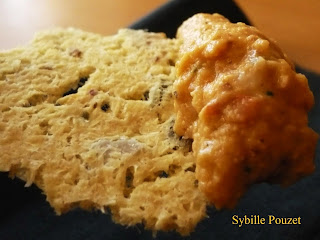 |
| My grandmother |
EN FRANCAIS AU BAS DE LA PAGE
My grandmother passed away last Thursday.
She was the eldest of 14 children. She had so many siblings that she had to learn how to take care of them at a very early age. A woman of action for sure she was.
Knitting, embroidering, knitting again, cooking, knitting while talking (very fast, very very fast she used to talk). Devoted to her family she was too. She always knew what everyone was up to. She was the link between us all.
A lot of memories came to my mind in the past few days, along with a good amount of tears.
One of them I wanted to share with you and thought it would be a nice way to keep her with us for a bit longer.
When we came to hers, we would never have a supper without a warm soup for starter, even in the summer!
Her vegetable soup is something I can not forget, and in her honour, I give you the recipe.
I cooked it last night. It was nice to share it.
The smells of the leeks in the pan and of the toasted sourdough bread brought me back to old days in her cold kitchen around the large wooden table…
She would go to the local market and buy beautiful vegetables from local producers. We used to eat it with delicious bread from the countryside “le pain de campagne”, massive slices of dense bread that we would dip in the soup… (You can find “pain poilane” in waitrose in London, toast it and enjoy…)
My grandmother's vegetable soup recipe
Serves 6
1 onion, peeled and chopped
2 leeks, washed and chopped
6 carrots cut in chunks
4 potatoes (about 600g), peeled and cut in chunks
1 large swede, peeled and cut in chunks
1 courgette*
Sea salt
Black pepper
2 TBSP olive oil
In a big saucepan, fry the onion and the leeks with the olive oil until they are transparent. Add the carrots, potatoes and swede. Season with salt and pepper. Cover with cold water and let it simmer for about 45min. Check if the vegetables are soft and if they are, blend the soup with a hand blender. Taste and adjust the seasoning.
Serve very hot and enjoy this hearty warming grandmother’s soup…
*the courgette adds creaminess to the soup. If you can’t find any because it’s not in season, simply leave it out. If you like, you can add a dash of cream to the soup before serving.
En français:
Ma grand-mère est partie jeudi dernier.
Elle était l’aînée de 14 enfants. Cela va sans dire qu’elle a dû très tôt apprendre à s’occuper d’eux, et à être toujours bien occupée !
Tricoter, broder, tricoter encore, cuisiner, tricoter en parlant (en parlant très vite, ah ça oui très vite), jamais elle ne s’arrêtai. Jeudi dernier, elle s’est enfin assise pour se reposer.














